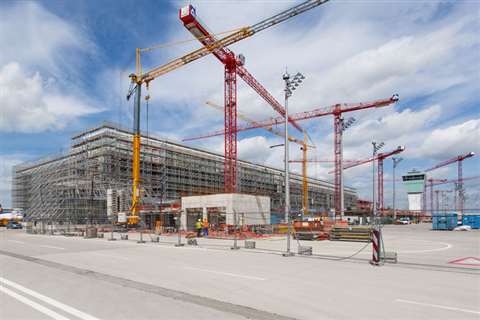Regional Report - Europe: Light at the end of the tunnel
02 September 2014

First the good news. It looks like the European construction sector will grow this year, after six years of falling output.
It will not be a huge bounce-back by any means. The European Construction Industry Federation (FIEC) puts the increase at just +0.1%, which would bring construction output in the EU to just over € 1,160 billion (US$ 1,550 billion).
Other organisations are more bullish. Euroconstruct, the group of European forecasting bodies predicts +1.3% growth for this year. Similarly, as Scott Hazelton of IHS Global insight writes in the September iC's Economic Outlook, that company’s forecast for Western European construction growth this year is +1.5%.
One of the problems with having so many sources to choose from is that it can be difficult to know where the truth lies. However, the main point is that the major forecasters see Europe’s construction industry coming out of recession this year.
The bad news is that no-one expects the recovery to be very spectacular. This has always been true for the European construction sector – the ‘boom’ of ten years ago only witnessed growth rates of about +3%. At the same time, red-hot emerging markets like China and India had construction sectors growing at +10% or more per year, and even other developed areas like the US grew at consistently higher rates.
This looks like it will be the case once again. The most optimistic forecasts have European construction growth hitting about +2.0% in two years’ time or so. This will be against a global average of +4% or better, with many major emerging markets expected to be up in +7% to +10% territory.
But it is always dangerous to generalise about European growth, because the region is made up of such a spread of countries with different growth characteristics and drivers.
The broad generalisation about the region these days is that the Northern countries are performing the best, and the situation gets worse in the South.
Most would agree that the most attractive European construction market this year is the UK, thanks to a booming housing market and a number of high-profile infrastructure projects like the Crossrail East-West rail project in London. Growth is put at +4.4% this year by Euroconstruct, with a further improvement expected next year.
There are one or two other European countries where growth might be stronger this year – Ireland and maybe Sweden – but the UK is a much more significant market. According to Euroconstruct, it is the third largest construction market in Europe, at € 169 billion (US$ 225 billion) in 2013, behind France and the regional powerhouse of Germany with its € 280 billion (US$ 370 billion) annual construction output.
Elsewhere in the North, the Nordic countries are also among the better performers in Europe, with Denmark, Norway and Sweden also showing good growth, although Finland has had a few ups and downs over the last year or so.
Kjetil Tonning, FIEC’s vice president with responsibility for the Nordic and Baltic countries, and vice president for business development at major regional contractor Veidekke said, “As I remember it, Sweden was the first to recover after the financial crisis. They recovered surprisingly fast.”
There are some good projects taking place in the region. Norway, Veidekke’s home country, is among the best-positioned thanks to its oil & gas wealth.
“It is stable,” said Mr Tonning, “not much change. You know what you can expect even if you change the government. For big investments in infrastructure, we are convinced they will continue doing what the last government did.
“The financial resources are there, even though the oil fund can only spend a limited part of its revenue on that. As long as the government has a policy saying that they are going to connect all the small villages, then we will have a lot to do because it is a huge country.”
Jernbaneverket, the Norwegian Rail Administration, is working on Follobanen, which is being designed to meet the increased demand for rail capacity in Oslo. It is expecting a 30% population increase by 2025, partly a result of migration to the capital for work. Jernbaneverket has highlighted potential for increased freight traffic as well as passenger trains.
Follobanen is a 22.5 km high speed line between Oslo and Ski stations, and Jernbaneverket said it would include Norway’s longest tunnel so far. It said by 2025, it expected 11,000 more travellers a day, an almost +70% increase in train passengers to the Oslo Central Station at rush hour, about 5,800 fewer car trips and about 750 fewer truck journeys a day.
Preparatory work is underway, and the main construction work will be carried out between 2015 and 2021.
Infrastructure is also a driver in Sweden, fuelled by the government’s National Transport Plan for 2014 to 2015, which includes the high-speed rail link from Stockholm to Linkoping, among others.
In addition, work is underway on the Stockholm metro. A 6 km commuter rail tunnel is being built beneath central Stockholm – the € 1.7 billion (US$ 2.3 billion) Citybanan project.
Weakness remains
In contrast to the strength in the UK, Sweden and Norway, all of which are outside the Euro Zone, things start to look a little weaker within the more core European countries, and particularly towards the South of the region.
In mid-Europe, there are signs that construction growth in Germany is slowing, even though Europe’s biggest market led the way out of recession a few years ago and had one of the region’s bolder national stimulus plans in the crisis years.
Things look even worse in France, where Euroconstruct says a construction recession has returned, following some encouraging signs in 2011. The organisation says it will be 2016 before the French construction sector grows again.
France’s economic stagnation provoked a major schism in the government in August, with prime minister Manuel Valls firing almost his entire cabinet for disagreeing with president François Hollande’s austerity policies.
The theme of austerity in Europe, championed by German chancellor Angela Merkel, is one that has also drawn criticism from the construction industry. FIEC vice president Jacques Huilllard said, “There can be no growth without investment. The policy of austerity which has been in favour for the last few years has done enormous damage both to the real economy in general and to the construction sector in particular.”
It is certainly true that austerity measures have bitten into public construction. FIEC’s figures show that infrastructure construction was down -3.7% in Europe last year, while the value of construction in the public non-residential segment fell -5.5%. It was only a more buoyant housing sector that limited the decline in overall construction output last year to -2.3%.
Undoubtedly the countries that have suffered the most since the crisis years have been the Southern peripheral economies such as Greece, Italy, Spain and Portugal.
Spain was once considered one of the ‘Big 5’ construction markets along with France, Germany, Italy and the UK. However, six years of double digit declines have seen construction output fall to € 65 billion (US$ 86 billion) last year, according to Euroconstruct, compared to a pre-crisis high of almost € 220 billion (US$ 290 billion) – the country’s construction market is worth just 30% of what it was seven years ago.
Having said that, Spain seems to have reached the bottom, and is showing signs of recovery, and that is stimulating business. For example, Valero Serentill, regional sales manager for equipment auction company Ritchie Bros said, “When you open a newspaper or read the news online, you see signs of recovery in Spain. The banks report fewer bad loans, GDP is expected to grow slightly, the tourism industry is still expanding and government stimulus-packages are rolled out to boost the industry.”
He said another reason for hope was the changes being made to business models in construction companies.
He added, “Before you can look to the future, you have to look closer at the present. An important and real change is that people are getting a grip on the reality of the market. Step by step you see big and small construction businesses all over Spain adapting their business model to the new needs and opportunities of the market.”
Figures from Euroconstruct forecast a return to moderate growth for the Spanish construction market in 2015, with a similar improvement expected for Italy and Portugal.
But forecasting is of course a dangerous business, and the circumstances that can change construction’s outlook are sometimes unexpected and can come around more frequently than the annual cycle of industry updates.
The European Commission’s statistical service, Eurostat provides monthly data, and since the second quarter of the year, there has been some suggestion that European construction growth could be reversing, or even stagnating. Worsening relations with Russia, insurgency in the Middle East and other global concerns are all having an impact on Europe’s weak economic growth.
As construction output tends to go up and down with the general economic cycle, there is a concern that even though these factors are well-removed from the industry itself, they could be enough to delay the recovery.







